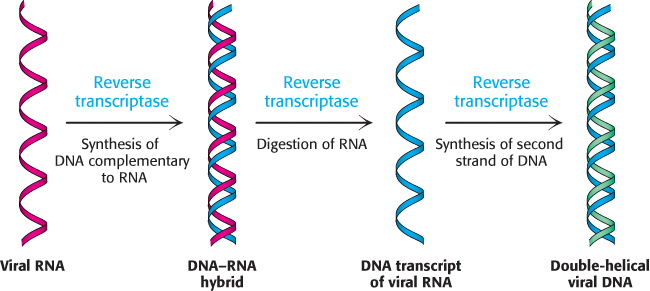4.4DNA Is Replicated by Polymerases That Take Instructions from Templates
DNA Is Replicated by Polymerases That Take Instructions from Templates
We now turn to the molecular mechanism of DNA replication. The full replication machinery in a cell comprises more than 20 proteins engaged in intricate and coordinated interplay. In 1958, Arthur Kornberg and his colleagues isolated from E. coli the first known of the enzymes, called DNA polymerases, that promote the formation of the bonds joining units of the DNA backbone. E. coli has a number of DNA polymerases, designated by roman numerals, that participate in DNA replication and repair (Chapter 28).
DNA polymerase catalyzes phosphodiester-bridge formation
DNA polymerases catalyze the step-

where dNTP stands for any deoxyribonucleotide and PPi is a pyrophosphate ion.

DNA synthesis has the following characteristics:
1. The reaction requires all four activated precursors—
2. The new DNA strand is assembled directly on a preexisting DNA template. DNA polymerases catalyze the formation of a phosphodiester linkage efficiently only if the base on the incoming nucleoside triphosphate is complementary to the base on the template strand. Thus, DNA polymerase is a template-
118
3. DNA polymerases require a primer to begin synthesis. A primer strand having a free 3′-OH group must be already bound to the template strand. The chain-

4. Many DNA polymerases are able to correct mistakes in DNA by removing mismatched nucleotides. These polymerases have a distinct nuclease activity that allows them to excise incorrect bases by a separate reaction. This nuclease activity contributes to the remarkably high fidelity of DNA replication, which has an error rate of less than 10−8 per base pair.
The genes of some viruses are made of RNA
Genes in all cellular organisms are made of DNA. The same is true for some viruses but, for others, the genetic material is RNA. Viruses are genetic elements enclosed in protein coats that can move from one cell to another but are not capable of independent growth. A well-
Another important class of RNA virus comprises the retroviruses, so called because the genetic information flows from RNA to DNA rather than from DNA to RNA. This class includes human immunodeficiency virus 1 (HIV-

119